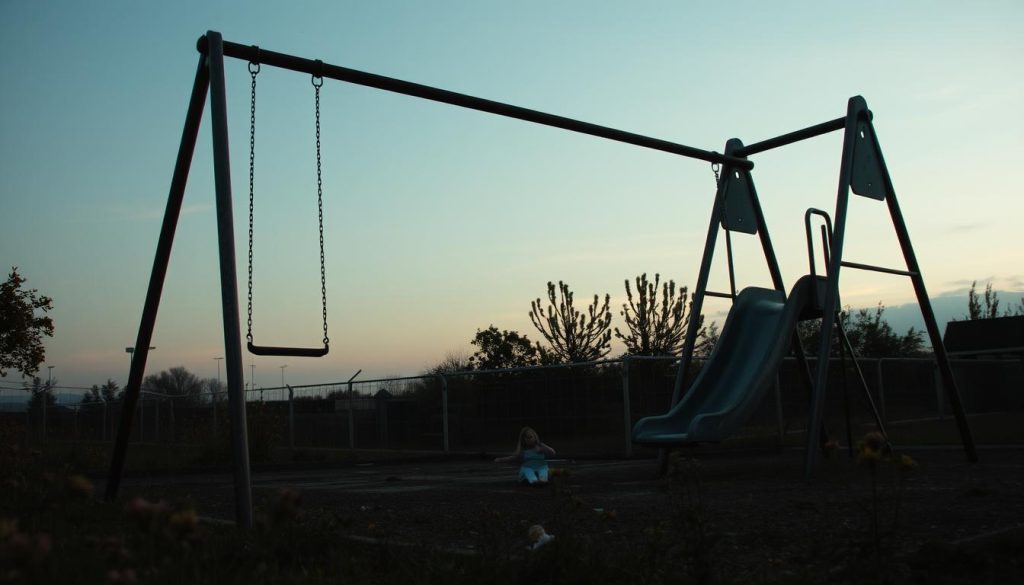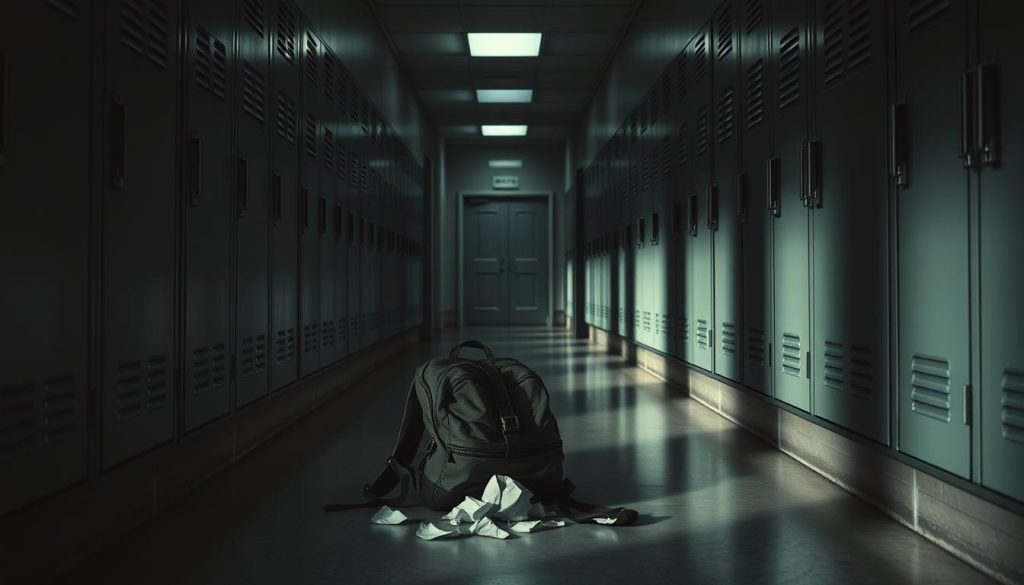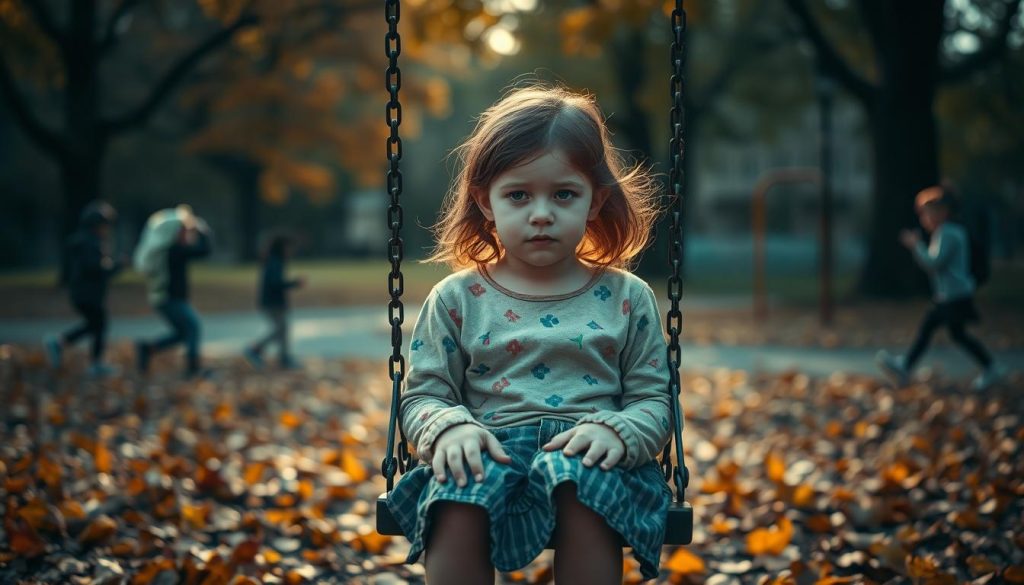I’m excited to share Laura Elizabeth’s important work. She focuses on girlhood misery, bullying, and beauty. Her goal is to help people overcome childhood trauma.
Exploring these topics helps us understand the challenges of girlhood misery and bullying. Laura Elizabeth’s work offers valuable support.
As I look into Laura Elizabeth’s work, I see the need for a safe space.
Her commitment to this cause is inspiring. Her work can deeply impact many lives. By sharing her insights, we can build a more caring community.
My Journey Through Childhood Trauma and Discovery
Growing up, I faced childhood trauma that shaped who I am today. These early experiences often left me grappling with self-esteem issues and persistent emotional struggles.

Understanding the Impact of Early Experiences
My early years were filled with challenges that affected my self-worth. The unresolved childhood trauma made it hard to build a strong sense of self. This led to ongoing emotional struggles.
The Intersection of Beauty Standards and Self-worth
Societal beauty standards played a big role in my self-esteem issues. Constant comparisons and unrealistic expectations hurt my confidence. They made my internal battles worse.
Finding Hope in Shared Stories
Connecting with others who faced similar childhood trauma gave me a sense of community. Sharing our stories offered mutual support. It helped alleviate emotional struggles and rebuild our self-esteem.
The Silent Epidemic of Girlhood Bullying
I’ve seen how widespread girlhood bullying is. It’s often ignored but deeply hurts many girls. They face emotional struggles from constant teasing and being left out.

Bullying over beauty standards is very harmful. Unrealistic beauty ideals make girls feel bad about themselves. This bullying beauty lowers self-esteem and causes long-lasting girlhood misery.
- Physical appearance criticism
- Social exclusion
- Cyberbullying
These issues lead to big emotional struggles. They affect mental health and how girls see themselves. It’s important to understand these problems to help the many young girls facing them every day.
Breaking Down Laura Elizabeth’s Approach to Healing
Laura Elizabeth’s methods have been a beacon of hope for me. Her way of healing from childhood trauma and bullying is both compassionate and effective.
Core Methodology and Framework
Laura Elizabeth uses a structured framework to help people overcome adversity. Her approach combines cognitive-behavioral techniques with mindfulness. This creates a balanced path to healing.
Tools for Emotional Processing
She provides various tools for emotional processing. These include guided journaling to express feelings and interactive workshops for sharing and empathy.
Building Resilience Through Understanding
Her approach focuses on building resilience. By understanding their past, people can develop the strength to move forward and thrive despite past challenges.

| Component | Description |
|---|---|
| Methodology | Cognitive-behavioral techniques combined with mindfulness for structured healing. |
| Emotional Tools | Guided journaling and interactive workshops to process emotions. |
| Resilience Building | Understanding past experiences to develop strength and adaptability. |
Girlhood Misery, Bullying and Beauty Combine for Laura Elizabeth
In my work with Laura Elizabeth, we see how girlhood misery, bullying, and beauty are linked. Laura knows these things don’t happen alone. They all play a part in how a young girl sees herself and feels.

Laura fights against bullying beauty. She says beauty shouldn’t make girls feel bad about themselves. Beauty should make them feel strong, not weak.
One example is a group of high school girls who were bullied for how they looked. Laura helped them. She used special tools and exercises to help them find their true selves.
Laura’s way of working is all about healing from girlhood misery. She creates a safe space where girls can share their stories. This helps everyone heal together. It’s not just about fixing the hurt from bullying. It’s about building a strong, lasting sense of self.
| Case Study | Challenges | Approach | Outcomes |
|---|---|---|---|
| High School Group Therapy | Bullying over appearance, low self-esteem | Emotional processing sessions, resilience exercises | Increased self-worth, reduced bullying incidents |
| Middle School Workshops | Peer pressure, body image issues | Interactive discussions, beauty standard education | Enhanced body positivity, supportive peer relationships |
Transformative Elements of the Program
Joining this program was a big step for me. It covers many areas of well-being.
Mental Health Support Components
The program offers strong mental health support. You get one-on-one counseling and group therapy. These help manage mental health and build resilience.
Self-esteem Building Exercises
The program has exercises to boost self-esteem:
- Daily affirmations to build a positive self-image.
- Journaling to reflect on yourself.
- Workshops on setting goals to increase confidence.
Community Connection Aspects
Building a supportive community is key. Connecting with others who face similar challenges boosts emotional support. It helps in growing personally.

Real Results and Personal Transformation
Many people have found a new path in life through Laura Elizabeth’s program. I’ve seen how they grow and overcome tough times.
Sarah, for example, turned her struggles into a source of strength. She went from being overwhelmed by bullying to becoming incredibly resilient.
- Overcoming adversity: Participants learn to navigate and triumph over their challenges.
- Personal growth: The program encourages continuous self-improvement and confidence building.
- Resilience: Individuals develop the ability to bounce back from setbacks stronger than before.
These stories show how well the program works. It helps people grow and become more resilient.
| Participant | Before the Program | After the Program |
|---|---|---|
| Sarah Johnson | Struggled with self-esteem and anxiety | Developed strong resilience and improved self-confidence |
| Mike Thompson | Experienced bullying and felt isolated | Overcame adversity and built a supportive community network |
| Emily Davis | Faced difficulties in personal relationships | Achieved personal growth and healthier relationships |
Critical Analysis: Strengths and Areas for Improvement
Laura Elizabeth’s program is a big help for mental health. Yet, there are ways to make it even better. Let’s look at the main points of the program.
Program Effectiveness
- Strengths: It tackles emotional struggles with strategies that really work for people.
- Areas for Improvement: Adding more interactive sessions could make it more engaging and useful.
Value for Investment
- Strengths: It offers a lot of resources that are worth the cost, like expert advice.
- Areas for Improvement: Having different price levels could help more people join.
Support System Quality
- Strengths: The support system is strong, always encouraging and keeping people on track.
- Areas for Improvement: Growing the peer support groups could create a closer community.
| Aspect | Strengths | Areas for Improvement |
|---|---|---|
| Program Effectiveness | Tailored strategies for emotional struggles | Increase interactive sessions |
| Value for Investment | Comprehensive resources and expert guidance | Introduce tiered pricing options |
| Support System Quality | Robust continuous support and accountability | Expand peer support groups |
Beyond the Program: Long-term Impact
Being part of Laura Elizabeth’s program changed my life. It taught me to face challenges with confidence.
My personal growth journey is ongoing. I’m more self-aware and driven to reach my goals.
Now, facing adversity doesn’t scare me. The skills I learned help me tackle obstacles and grow stronger.
- Enhanced Resilience: Ability to bounce back from setbacks.
- Continuous Personal Growth: Ongoing self-improvement and development.
- Effective Overcoming of Adversity: Tools and strategies to handle future challenges.
| Long-term Benefits | Description |
|---|---|
| Resilience | Strengthened capacity to recover quickly from difficulties. |
| Personal Growth | Continuous development of self-awareness and personal skills. |
| Overcoming Adversity | Improved ability to handle and overcome future challenges. |
Conclusion: A Path Forward Through Understanding and Healing
Laura Elizabeth’s insights show how tackling childhood trauma affects our mental health. Her approach is kind and helps those dealing with girlhood misery and bullying. It’s key to understand these early experiences to build strength and well-being.
Laura stresses the need to care for our mental health early on. By facing and dealing with past hurts, we can look forward to a hopeful future. Her work is a light for those facing similar struggles, offering practical help and support.
Following Laura’s methods builds a community of shared healing. It shows we’re not alone and healing is possible through connection. Taking care of our mental health today leads to a better tomorrow.
Let’s carry Laura’s lessons of empathy and resilience with us. By focusing on mental health and tackling childhood trauma, we can build a supportive space for all. Laura’s work shines a light on these important topics and motivates us to heal and grow.
